Erik ten Hag’s Manchester United: A Tactical Mess
When Erik Ten Hag was hired at Manchester United, he was tasked with building a dynamic team that plays exciting attacking football.
Entering his third season, a lot of fans—myself included—are trying to understand what his plan is. In this article, I will try to provide a simple analysis of what ten Hag is trying to do and why it is failing.
Furthermore, this article is not a criticism of the manager but rather an explanation of what he is trying to do and why it is not working. And perhaps a couple of suggestions on how to fix these issues!
The Idea
Simply put, the Dutch coach’s idea for Manchester United is to build the best team in the world on transitions. Transitions in football can happen three ways.
The first is playing in low block and hitting opponents on the counter.
The second is the creation of artificial transitions. Artificial transitions happen when a team builds up slowly to bait the opponent press and then goes vertical with the ball as fast as possible to bypass the press and create numerical superiority in attacking the opponent.
The third is pressing high, recovering the ball when the opponent’s defense is not set. The best example of this is Liverpool’s Jurgen Klopp teams.
What ten Hag was trying to achieve worked in some games. Tottenham in 2022, Chelsea in 2023, and Manchester City in 2024. Against Tottenham and Chelsea, United suffocated their opponents by pressing high, benefiting from their opponent’s defense not being set to create chance after chance. Against Manchester City in the FA Cup final, the Red Devils played in a mid block and hurt the Citizens on the counter twice.
While it works sporadically, Manchester United fans are wondering why it is not working in all games. That is because there are some deficiencies in the way ten Hag and Manchester United are trying to apply this approach.
Building Slowly & Then Going Long Fast
A lot of Manchester United fans wonder why they looked their best when Weghorst played. It is because the Dutch striker had the ability to win the long balls due to his height, which helped Manchester United create these artificial transitions.
Since Weghorst left, the Red Devils have not had a striker who can win the long ball and hold up play. Rashford and Garnacho generally are at a physical disadvantage when they try to wrestle the ball from more physical defenders.
The damage of going long is that it hurts United’s defense. This was clear in the Liverpool game. When the ball was intercepted from Casemiro and Mainoo, Liverpool had a numerical advantage, although the ball was on the United side of the pitch. Why did this happen?
The answer is simple, as Arne Slot explained it: United try to create a numerical superiority and push their full backs higher. That means that one bad pass or individual error could lead to United being vulnerable in defense.
The main issue with this approach is that long balls are generally not accurate. It leads to a high-risk, low-reward approach where you leave your backline exposed in case you don’t win the long ball. Or if there is an individual error.
Also, this approach needs a lot of understanding between the backline and front line to work. One player running forward a bit too fast leads to an offside. This was evident in the Brighton game, where United could not beat the offside trap because they were too rushed in their attacks. It also requires accuracy when playing one-touch long balls, which is not an easy thing to do in football.
In short, United get frustrated when opponents do not bait on their slow buildup approach and opt for a difficult or risky pass. This leads to them being put in unfavorable defensive situations more often than not.
Build Up Structure
The Red Devils generally build in a 3-1-6 structure. Casemiro drops to the backline to help the center backs with ball progression. The issue in this structure is that Bruno Fernandes, the wingers, and the striker occupy the last line of the opposing defense. Both fullbacks are also closer to the last line of their opponent’s defense than their own back line.
These six players occupying the last line of defense mean that the opponent can dictate the pitch if their backline is deep. This leaves United either recycling the ball between Casemiro, the center backs, and Onana or going for a long ball and a risky pass, which may be intercepted for a transition.
It is easier to combat this approach for any opponent, as they will always have numerical superiority. They can go man-to-man against the United front line, betting on the low percentage of long balls. They can throw extra men in midfield to trap Mainoo and cut all easier passing lanes for the front line and Bruno.
Look at how high Amass and Wan-Bissaka are in this picture. Liverpool are happy leaving Amass because the only way the ball will reach him is with a diagonal 35-yard pass. Any opponent will take that all day.
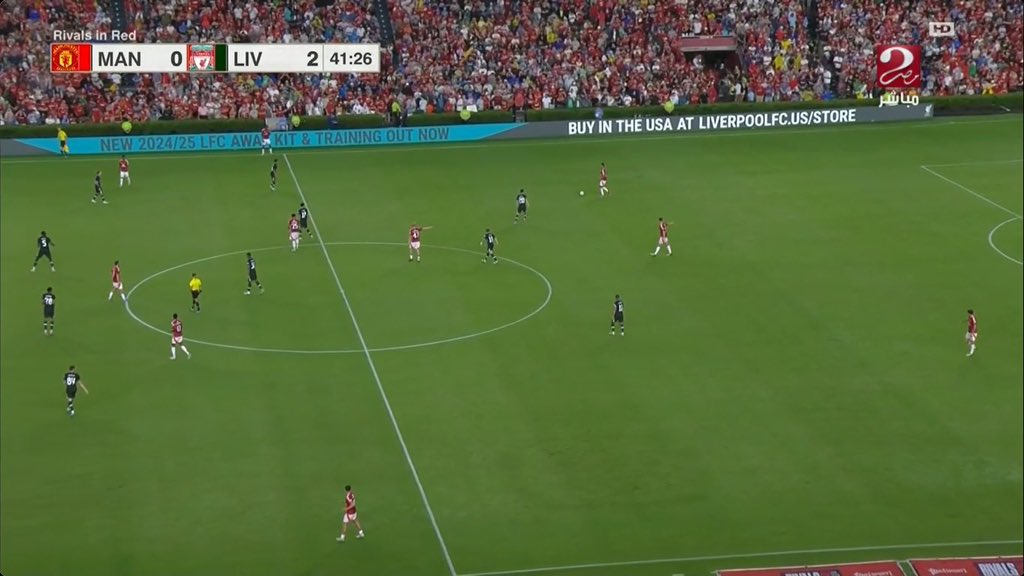
Another example of the above issues is here. Fulham are already trapping Mainoo. Adama Traore is ready to jump if a pass goes to Lisandro. Emile Smith-Rowe is ready to either double up on Mainoo or jump a pass to Casemiro. All passing lanes are closed. The only progressive safe pass here is for Dalot, which is a 30 to 35-yard diagonal pass. That pass is so difficult to execute, again making Fulham at peace and giving it to United all game.
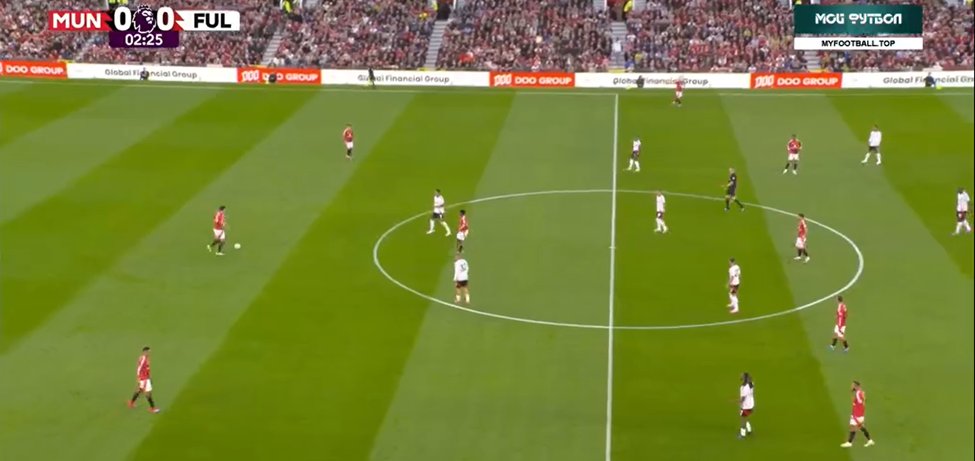
Because of how high the fullbacks are, it needs a difficult pass to reach them. Any team will take its chances of the opponent players not being able to execute these difficult passes.
This gives the opposing wingers a chance to do a hybrid pressing role; they can cut what is already difficult passing lanes to the full backs while pressing the center backs. This gives teams numerical superiority, as United has one of the full backs out of play. The opponent has an additional player to trap United or close the passing lane depending on the plan.
In conclusion, if United executes that long ball accurately, they will have their winger and full back isolated on the fullback of the opponent. The problem is that executing the correct weighted long pass time and time again in the same game is close to impossible, and this is why opponents take their chances with letting United try.
The Red Devils build up in a very risky approach that is easy to combat. United uses a high risk low reward approach in their buildup, which harms their defense and their ability to counter opponents transitions.
Pressing Structure
United’s pressing structure issues have been well known. Their full backs don’t back the press, leaving the now famous huge gaps in midfield. One of Manchester United’s attacking methods is pressing high and intensely with their six-man front. Casemiro, Mainoo, Bruno, and the three of the front line press high, trying to force turnovers.
The Red Devils use their press as their best attacking weapon, getting the ball off their opponents with their rest defense not set.
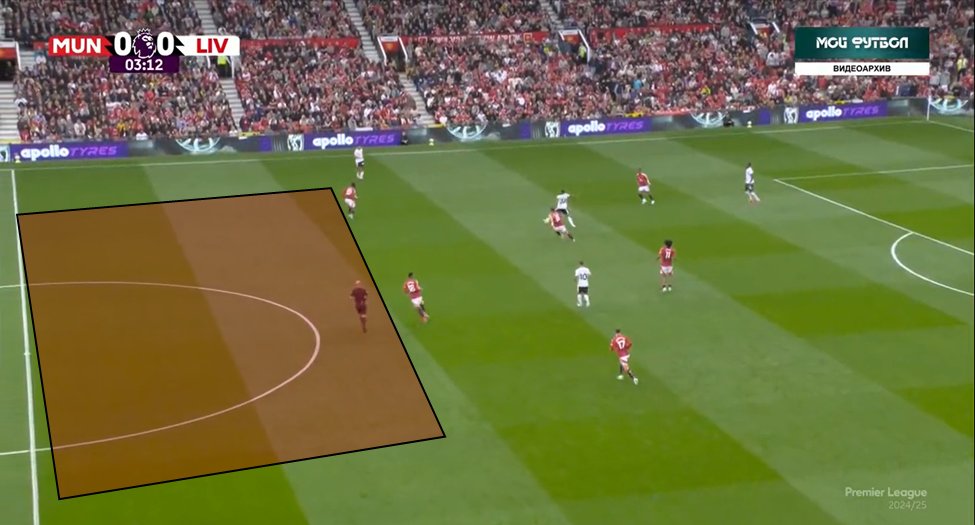
The problem with Manchester United’s approach is that they are not compact. Their defensive line does not back their approach, hence these gaps in midfield appear. In the Fulham game, whenever Marco Silva’s side bypassed the press, they had a free run to their backline.
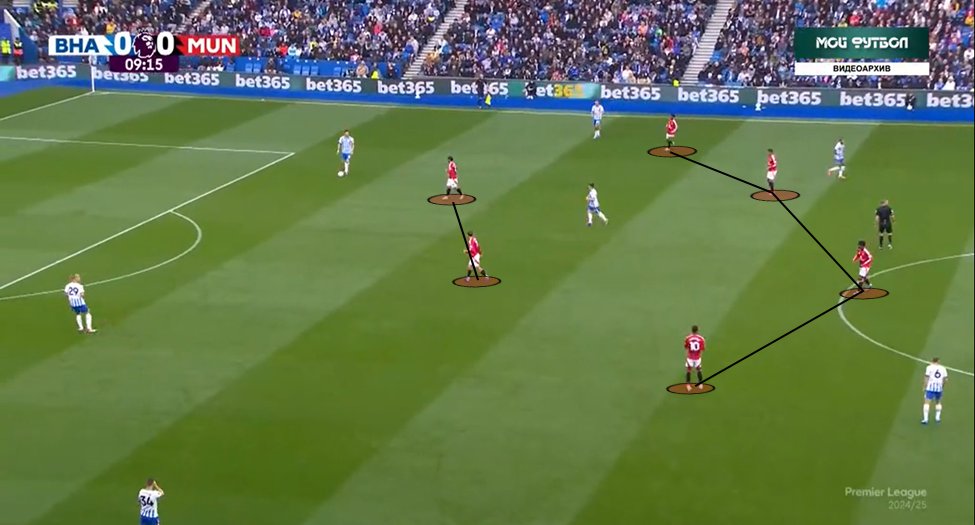
Another example here. United are pressing Brighton with a 6-man front, but it is very narrow. Brighton can easily bypass this press if Dunk gives it to van Hecke, who has easy circulation to the full back who has acres of space in front of him.
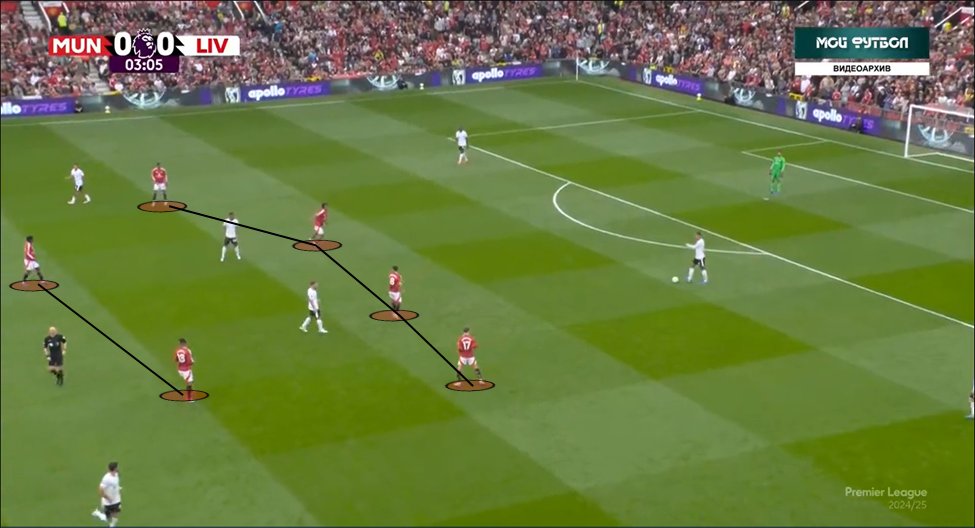
Again here, the United backline is not backing the press, and the team is not compact. Adding Alisson to the Liverpool buildup, they have a 3-3 structure to build up with with already numerical superiority if they bypass United’s first line of press.
For years, high press was Liverpool’s best tool to create chances and sustain pressure over their opponents. Ten Hag is trying to build this United team in the mold of Klopp’s Liverpool, but his team is not compact and does not press as a unit but more as individuals.
The United backline does not back their press, which leads to being a team that presses high and defends deep. This is a recipe for disaster, which makes the pitch bigger for their opponents.
Last season, Manchester United were the team that conceded the second most shots in the league after Sheffield United. Their injuries are well documented, but their approach led their injury-ravaged backline to be outnumbered more often than not.
Playing Too Fast
As a team, Manchester United seems that they play matches on fast forward. They thrive on chaos, and their best performances came in chaotic games. Even when the Red Devils win games, they don’t have control over them.
One example comes to mind this season. In the Fulham game, with United winning 1-0 in the 92nd minute, Zirkzee stopped a counterattack and opted for ball retention. How many times since last season United had the ball while leading and opted to attack too fast only for the ball to be intercepted and them conceding?
The way they play is not a way of a team that tries to exert control but a team that thrives in chaos. Also, trying to play too vertically and quickly at the same time exhausts players, leading to their fitness level dropping by the end of games. When players are tired, they make mistakes.
Watching ten Hag’s team, everything seems rushed. They never try to slow down the play, exert control, and exhaust their opponents. This is why their games feel like tennis games, they go vertical and quickly while bombarding players forward only for the opponent to intercept and them to go quickly, benefiting from the gaps in United midfield.
The Old Trafford club never dictate the game nor benefit from the game state. If result and time are not on the screen, you will never know whether United are winning or losing because of how they always seem to play the 90 minutes on fast forward.
The Solution?
Manchester United right now feels like Klopp’s first two seasons at Liverpool. They can score four but concede six. Their games look like tennis games, not football. They do not try to exert control. They are so open, they play too fast, and their approach in press, midfield, and buildup is high risk, low reward. The problem with the Red Devils is that their approach and idea is not one of a team that is TRYING TO HAVE THAT CONTROL.
Manchester United system also do not enhance their best players abilities. It asks Casemiro to progress the ball and play diagonals, something he was never adept at doing since Madrid days. It forces Bruno up high where he receives with his back to the game instead of receiving with his face forwards and in the middle third. It makes Rashford hug the touchline and asked to beat players instead of narrowing the spaces and relying on his interplay with the full back and the striker where he is at his best. It relies on Lisandro Martinez to win every duel he challenges. Yes, individual mistakes are common by Manchester United players but Ten Hag is not setting them for success by playing a system too difficult to execute and not suitable to their abilities. When your games plan relies on each player executing their roles perfectly for all 90 minutes, more often than not an individual mistake will destroy whatever you are trying to do.
Why is Ten Hag persisting with it? I don’t know. I am sure If I can see it, Erik Ten Hag surely sees it too. If you want to create artificial transitions, do not go long and lose the ball again and again. The Dutch coach may think it is the best system going forward, but I would argue that United needs to reinvent their tactical idea. Slow down the game; build up in 3-2-2-3 rather than 3-1-6. Return back to a midblock; you do not need to be a high-pressing team to dominate your opponents.
Ten Hag needs to stop creating the best transition team in the world and needs to get back to what worked for him at Ajax. His team exerting control, playing slow or fast depending on the state of the game. United needs to start dictating games to the opponents, break down low blocks by attacking patterns, not just play fast and hope for the best. Till this day, ten Hag does not seem like a manager trying to input his tactical idea but adapting to the squad at his disposal. He seems like a man in two minds.
Ten Hag can blame individual errors, brag about winning trophies, talk about injuries, deflect questions in press conferences, or whatever, but the structural issues were clear to see from last season. Individual errors and lack of basic application from the players make it seem worse but the idea is not good enough. A bad plan combined with individual mistakes and a lack of basic application makes Manchester United look closer to the the Championship level than top four.
It’s time to start looking at the system these players are operating in when they consistently make the same individual mistakes. These are professional football players, not amateurs. Even if the Dutch coach thinks his plan is the best, if his players can not execute it, it will be useless.
Ten Hag needs to find a solution for these gaps in midfield, otherwise, they will cost him his job, and he will only have himself to blame. Playing fast and hoping for the best is not a way to build a title winning team.


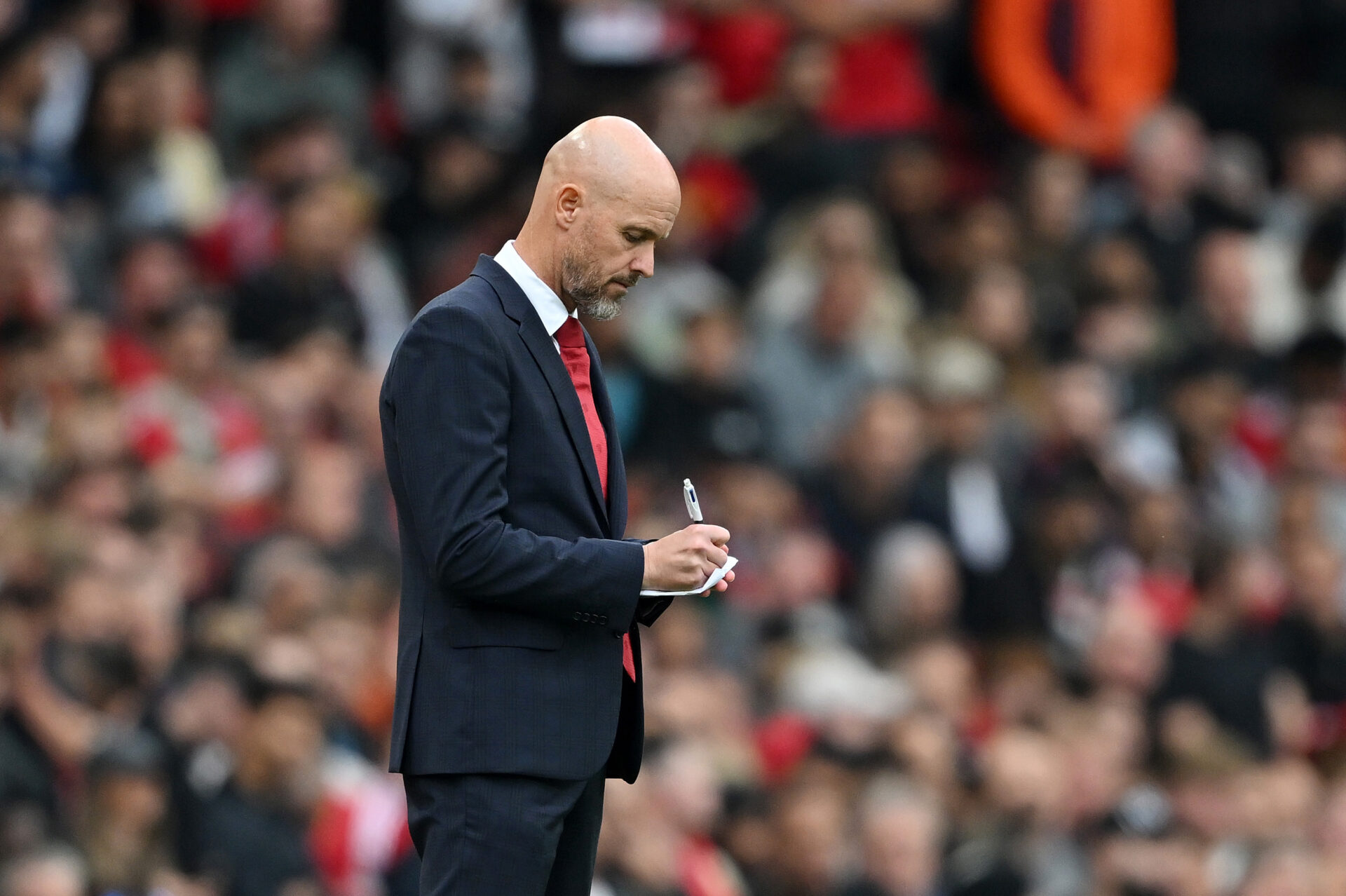

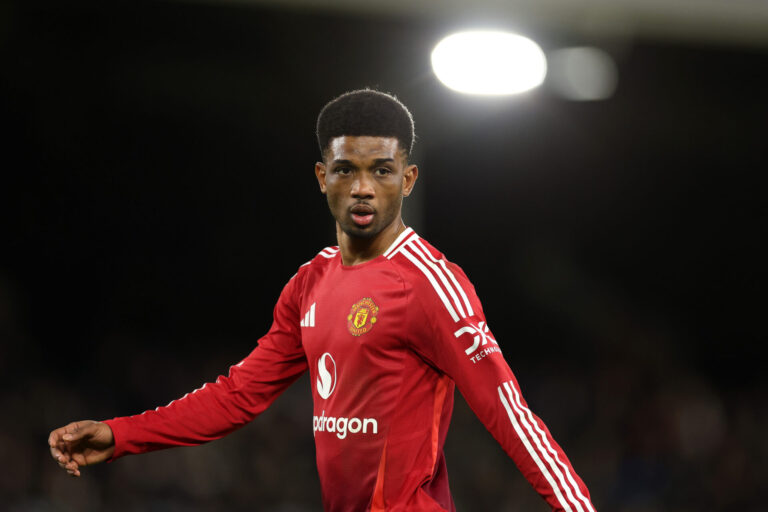
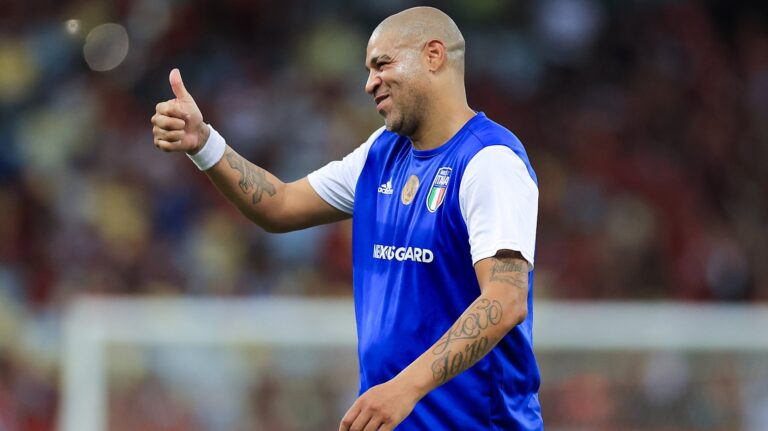
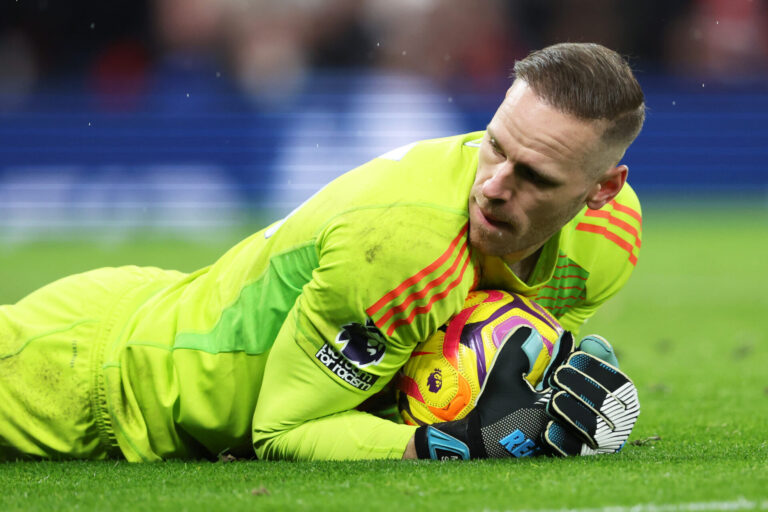
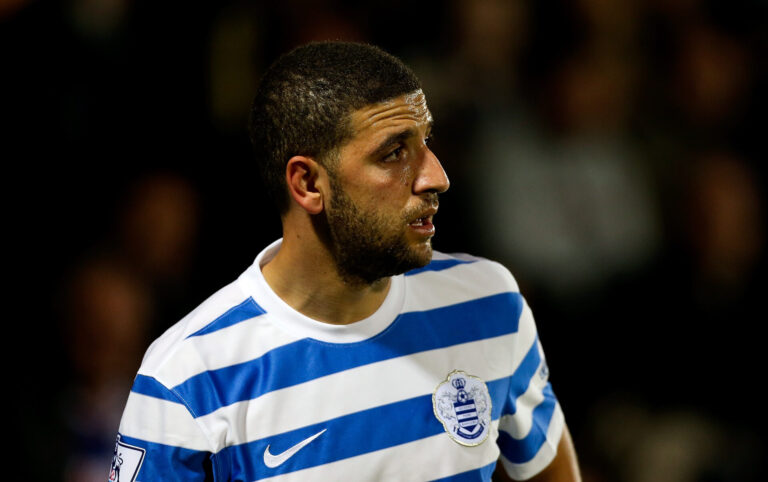
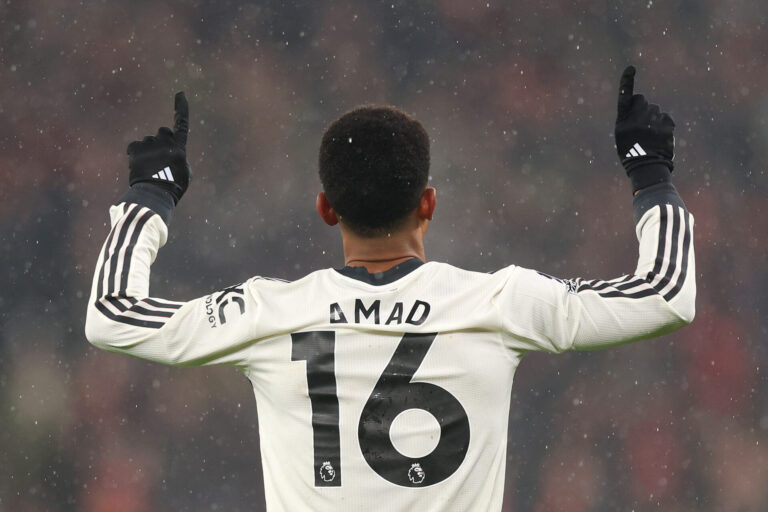
One Comment